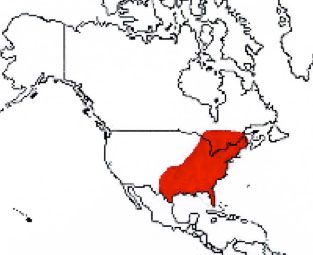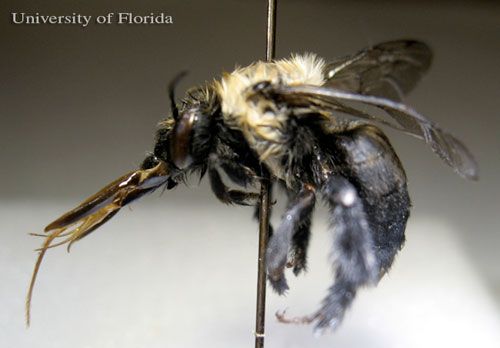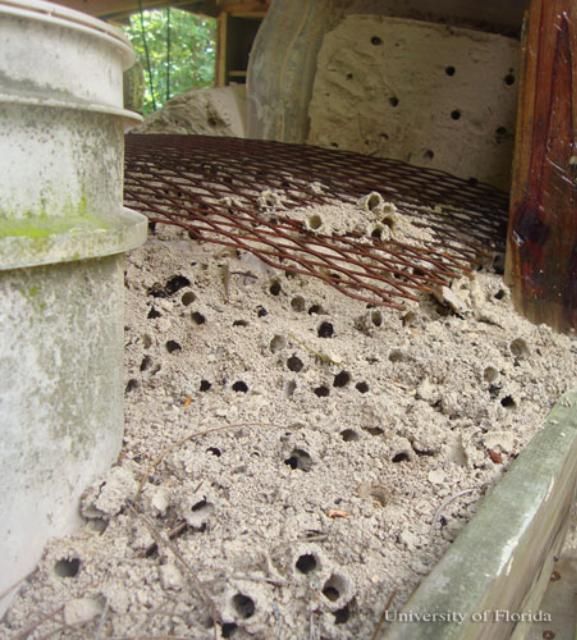The Featured Creatures collection provides in-depth profiles of insects, nematodes, arachnids and other organisms relevant to Florida. These profiles are intended for the use of interested laypersons with some knowledge of biology as well as academic audiences.
Introduction
Anthophora abrupta Say, also known as the chimney bee or miner bee, is a gregarious, yet solitary, ground-nesting bee. The adult female digs a tunnel, often in clay, using the excavated earth to sculpt a chimney-like turret representing a single nest. Neighboring nests are clustered like a small village, but Anthophora abrupta are considered solitary bees because they have no overlap of generations and each female cares only for her own nest and future offspring.
Anthophora abrupta were described poetically by Rau (1929):
"...conspicuous as they noisily swing their ponderous bodies to and fro on the wing, arrive home and scramble into their burrows or come tumbling out headlong and dash off into the sunny fields, with all the exuberance of boys just out of school."
Anthophora abrupta are not aggressive or even defensive of their nests and do not typically sting. When roughly handled they can defend themselves by biting, but are otherwise docile and should not be considered a threat. In fact, they are beneficial pollinators and have been recorded on a variety of flowers. Anthophora abrupta are not timid around humans, so the interested observer can watch as the turrets multiply and the adult bees stock their burrows with pollen and nectar.

Credit: Jason Graham, University of Florida
Synonymy
Anthophora sponsa Smith (1854)
Anthophora (Anthomoessa homonym) abrupta Say (1837)
Distribution
Anthophora abrupta range from Texas to the east coast of the United States and from Florida into Canada. Florida records of Anthophora abrupta have been uncommon since the 1980s. In 2010, a population was found nesting in colloidal clay in an open air shed in Gainesville, Florida, providing specimens for the photos included in this document.

Description
Superficially, adult Anthophora abrupta look like small, fast bumble bees. The head, legs, and abdomen are lightly covered in brown-black hairs, while the thorax is covered in dense, pale yellow-orange hairs. The wings are nearly transparent to slightly cloudy with brown-black veins.
The adult female Anthophora abrupta are 14.5–17 mm long. Their cheeks are approximately the same width as their eyes and they have a strongly protuberant clypeus (the area on the center of the face between the eyes and mouth) (Mitchell 1962).

Credit: Glenn Hall, University of Florida

Credit: Katie Buckley, University of Florida
The adult male Anthophora abrupta are 12–17 mm long (Mitchell 1962). The males have a distinctive set of hairs on the margin of their yellow clypeus, earning them the common name "the mustached mud bee." The males carry pheromones attractive to females in their mustaches (Lee 1998).
The eggs are pearly white, about 2.5 mm long and about 1 mm wide, and look like small and slightly bent pieces of rice. Full-grown larvae are lemon yellow and average 13 mm in length and 5 mm at the greatest diameter (Frison 1922).
Life Cycle and Biology
Adult Anthophora abrupta begin emerging from March to late June, depending on region and climate, and have been recorded as late as August. The males emerge first, followed by the females about five days later. There is a skewed sex ratio of approximately two males to every female (Norden 1984).
Mating takes place on a flower, and while the females have been observed to mate only once, the males seem to mate with multiple females. After mating, the female looks for a suitable nest site. Adult females who emerge early in the spring fly in a zigzag motion inspecting cracks and holes in the substrate and then choose a spot to begin excavating a nest. Adult females who emerge later in the spring tend to nest in a clumped distribution around the earlier emerging adult females' nests.
After digging their burrows, Anthophora abrupta females line the walls and cells with a glandular secretion excreted from their Dufour's gland (a gland near the base of the abdomen associated with egg-laying). It begins as a clear liquid and then turns into a solid plate with wax-like consistency. This process essentially waterproofs the cell, making it cup-like for the provisioning of the egg.
Adult Anthophora abrupta females forage on several plants, collecting pollen and nectar. They place a few loads of dry pollen into an excavated cell and moisten it with nectar and more secretions from the Dufour's gland. The females then mix these substances into a soupy mass. They then lay a single egg onto the pollen mixture and seal the cell with clay, leaving a single pore in the capping.
The Anthophora abrupta egg floats on the pollen mixture for about five days before hatching. The larvae develop through four instars over the following three weeks, during which they eat the pollen mixture and cell lining. Fourth instar Anthophora abrupta larvae defecate over the following four days and then, without molting, the larvae transform into prepupae. As prepupae, they overwinter for approximately nine and a half months with their head capsule directly below the cap of their cell.
At the end of the pupation period, the Anthophora abrupta shed their prepupal skin and darken for approximately two and a half weeks. They then emerge from their burrows in spring or summer, depending on region, and begin life as adult bees.
The pupation of Anthophora abrupta is dependent on climate conditions. Frison (1922) studied the development of larvae in the laboratory and in natural field conditions. The larvae in the warmer laboratory climate pupated in March whereas the larvae in natural conditions did not pupate until May. In either case, the pupal stage lasted 7-14 days, however bees that pupated early in the laboratory died shortly after emerging.
Nest Architecture
The nesting architecture seems to be the most studied aspect of Anthophora abrupta. This may be due to the conspicuous, chimney-like turrets that adorn the entrance to their burrows. The adult female digs a tunnel, often in clay, and the excavated earth is used to sculpt the turret. Each chimney-like turret represents a single nest. The nests are often found on cliff banks or clay adobe walls. The adult females collect water to soften the hard packed clay. Anthophora abrupta nests are often found on clay banks at the edge of creeks and rivers. In a few cases, Anthophora abrupta nests have been found under an overhang, such as a bridge or tree.

Credit: Jason Graham, University of Florida
The turrets are complete after about six hours of building, and average about 8 cm in length, though they vary in shape, length, and direction. The turrets are smooth in the interior and rough on the outside. On the ceiling of the downward facing turrets, there is a characteristic slit that has been suggested to provide ventilation. Several ideas have been proposed for the purpose of the turrets, such as protection from rain or parasites, preventing burrows from being filled by nearby excavations or windblown debris, serving as nest recognition, a social significance (a landmark enticing other solitary adult Anthophora abrupta females to nest close to one another), or as solar heaters.
Turret construction concludes when the adult Anthophora abrupta female bees finish excavating the tunnel and move to constructing the cells. The tunnels average about 11 cm in length. The urn-shaped cells are excavated into the sidewalls of the tunnel with about seven cells per burrow. The cell is lined with Dufour's gland secretions, as is the cap that the female adds after egg laying. After all the cells are occupied with an egg, the female plugs the tunnel with a 5–10 mm thick layer of packed clay. The nest sites have been conservatively estimated to contain as many as five thousand cells.
The nests are in very close proximity to one another and occasionally multiple females have been observed using the same nest entrance. The bustling of Anthophora abrupta at the nests during peak activity has been described as a "crowded and busy town."
Forage Plants and Habits
Male and female Anthophora abrupta visit various flowers and will forage in light rain and in temperatures between 11°C–39°C (51°F–102°F). They spend most mornings foraging and afternoons in nest construction.
The following is a list of plants that Anthophora abrupta have been recorded visiting, but this list should not be considered all-inclusive, as Anthophora abrupta seem to be flower generalists. Forage plants recorded by Frison 1922 (F); Norden 1984 (N); Lee 2007 (L); Rau 1929 (R):
- Anacardiaceae: Rhus typhina L., staghorn sumac (N)
- Asclepiadaceae: Asclepias purpurescens L., purple milkweed (F)
- Asteraceae: Taraxacum officinale Wiggers, common dandelion (N)
- Balsaminaceae: Impatiens pallida Nutt., jewelweed (N)
- Boraginaceae: Hydrophyllum virginicum L., Virginia waterleaf (F); Mertensia virginica L., Virginia bluebells (F)
- Caprifoliaceae: Lonicera japonica Thunb., Japanese honeysuckle (N)
- Celastraceae: Celastrus orbiculatus Thunb., oriental bittersweet (N)
- Convolvulaceae: Calystegia sepium L., larger bindweed (F)
- Ebenaceae: Diospyros virginiana L., American persimmon (N)
- Ericaceae: Vaccinium oxycoccos L., cranberry (L)
- Fabaceae: Coronilla varia L., crown vetch (N); Trifolium repens L., white clover (N); Vicia caroliniana Walt, Carolina vetch (N)
- Fagaceae: Castanea mollissima Blume, Chinese chestnut (N)
- Lamiaceae: Nepeta cataria L., catnip (N)
- Liliaceae: Asparagus officinalis L., asparagus (N)
- Plantaginaceae: Penstemon laevigatus L., eastern smooth beardtongue) (F); Penstemon pubescence Aiton, manyflower beardtongue (F)
- Ranunculaceaea: Ranunculus bulbosus L., bulbous buttercup (N)
- Rhamnaceae: Ceanothus spp. buckthorn (F)
- Rosaceae: Gillenia stipulata Baill., American ipecac (F); Rosa humilis L., Carolina rose (F); Rosa multiflora L., rambler rose (R); Rosa setigera Michx., climbing rose (F); Rubus allegheniensis Porter, Allegheny blackberry (N); Rubus idaeus Rich., red raspberry (N)
- Saxifragaceae: Deutzia scabra Thunb., fuzzy deutzia (N)
- Solanaceae: Lycopersicon esculentum Miller, tomato (N); Solanum dulcamara L., nightshade (N)
Economic Importance
Anthophora abrupta are potential pollinators of many important crops, including cranberry, tomato, blackberry, asparagus, persimmon, clover, and raspberry. Pollinator management techniques have yet to be developed for Anthophora abrupta. However, Anthophora abrupta show certain qualities (forage-plant generalist, nest in the same location for many years, gregarious nesters, non-defensive) that highlight them as ideal candidates for future study.
Selected References
Frison TH. 1922. "Notes on the life history, parasites, and inquiline associates of Anthophora abrupta Say, and some comparisons with the habits of certain other Anthophorinae (Hymenoptera)." Transactions of the American Entomological Society 48: 137–156.
Lee J. (2007). Cranberry-Pollinating bee wears a mustache. USDA Agricultural Research Service. http://www.ars.usda.gov/is/AR/archive/sep98/poll0998.htm (31 May 2016)
Norden BB. 1984. "Nesting biology of Anthophora abrupta (Hymenoptera: Anthophoridae)." Journal of the Kansas Entomological Society 57: 243–262.
Norden BB, Scarbrough AG. 1982. "Predators, parasites and associates of Anthophora abrupta Say (Hymenoptera: Anthophoridae)." Journal of New York Entomological Society 90: 181–185.
Rau P. 1929. "The biology and behavior of mining bees, Anthophora abrupta and Entechnia taurea." Psyche 36: 155–181.